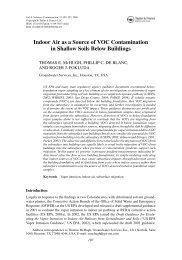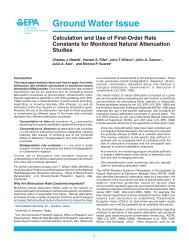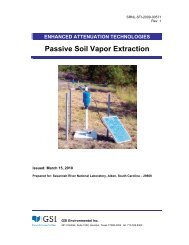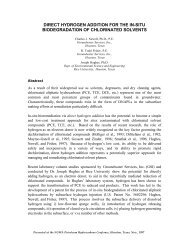Parameter Estimation Guidelines for Risk-Based Corrective Action ...
Parameter Estimation Guidelines for Risk-Based Corrective Action ...
Parameter Estimation Guidelines for Risk-Based Corrective Action ...
You also want an ePaper? Increase the reach of your titles
YUMPU automatically turns print PDFs into web optimized ePapers that Google loves.
TABLE 3. PARAMETER SELECTION GUIDELINES: LATERAL GROUNDWATER TRANSPORT MODEL (EQUATION LT-1) continued<br />
Input <strong>Parameter</strong><br />
Symbol Description Typical Range <strong>Parameter</strong> Measurement or <strong>Estimation</strong> <strong>Guidelines</strong> Reference<br />
SITE-SPECIFIC PARAMETER MEASUREMENTS (CONT'D)<br />
k s Soil-water sorption coefficient (g-H 2 O/g-soil) For organics, estimate as: k s =k oc x f oc . For ionizing organics (e.g.,<br />
chlorophenols), estimate k s based on published pH dependent<br />
partitioning coefficients <strong>for</strong> ionized and neutral <strong>for</strong>ms. For inorganics,<br />
estimate k s as published pH-dependent isotherms, based on measured<br />
groundwater pH. See EPA SSL Guidance <strong>for</strong> detailed in<strong>for</strong>mation.<br />
f oc Fraction of organic carbon in soil (g-C/g-soil) 0.001 - 0.03 Measure depth from ground surface to top of affected source zone.<br />
Measure average vertical dimension from top to base of affected soil<br />
zone over area corresponding to W. Generic lowerbound value of<br />
0.001.<br />
BC i Biodegradation capacity <strong>for</strong> constituent i Site-specific If using electron-acceptor superposition <strong>for</strong>m of Domenico model<br />
(Equation LT-1b), calculate BC i value as indicated on Figure 3.<br />
Detailed instructions <strong>for</strong> BC i and BC T estimation are provided in<br />
BIOSCREEN user's manual (Newell et al, 1996). Calculation must be<br />
based on site-specific measurement of principal electron acceptor<br />
concentrations in site groundwater.<br />
X Distance from source to downgradient POE (cm) Site-specific Measure from source term location to downgradient POE location<br />
along line of groundwater flow.<br />
S w Groundwater source term width (cm) Site-specific See Figure 4 <strong>for</strong> guidelines regarding site-specific determination of<br />
source width of water-bearing unit.<br />
S d Groundwater source term thickness (cm) Site-specific See Figure 4 <strong>for</strong> guidelines regarding site-specific determination of<br />
source thickness in water-bearing unit.<br />
REASONABLE PARAMETER ESTIMATES<br />
θ e Effective porosity of water-bearing unit (cm 3 -<br />
pore/cm 3 -soil)<br />
0.001 - 0.1 Match to representative value <strong>for</strong> predominant soil type in waterbearing<br />
unit, as follows:<br />
Clay = 0.01 - 0.20 Silt = 0.01 - 0.30<br />
Fine Sand = 0.10 - 0.30 Med. Sand = 0.15 - .30<br />
Coarse Sand = 0.20 - 0.33 Gravel = 0.10 - 0.35<br />
U.S. EPA, 1996<br />
La Grega, 1994<br />
Newell et al, 1996<br />
Connor et al, 1995<br />
Connor et al, 1995<br />
Connor et al, 1995<br />
Connor et al, 1995<br />
Domenico et al, 1990<br />
Walton, 1988<br />
NGWA Petroleum Hydrocarbons Conference 17 <strong>Parameter</strong> <strong>Estimation</strong> <strong>Guidelines</strong><br />
Houston, Texas, November 1996<br />
<strong>for</strong> RBCA Modeling






